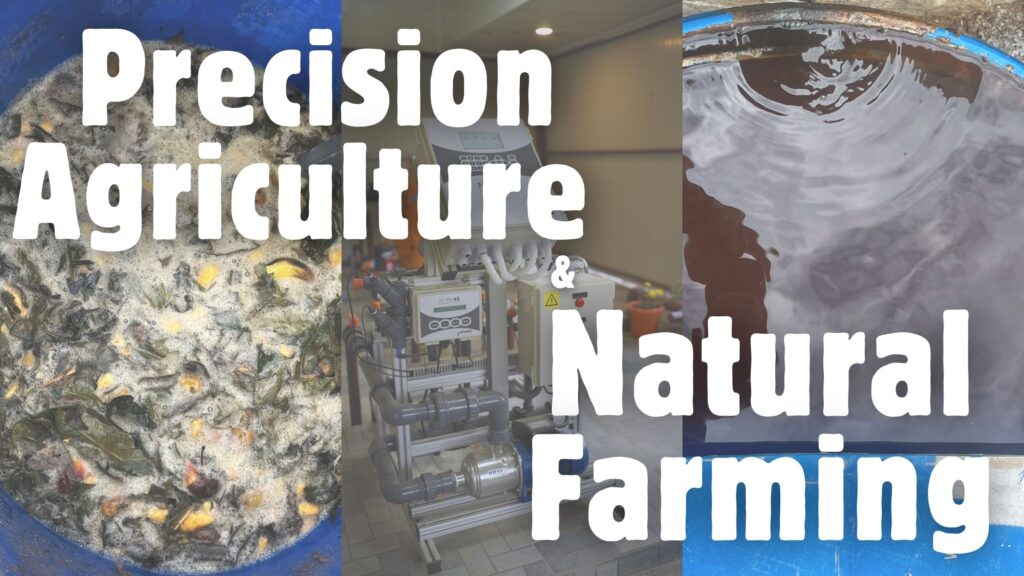
Revolutionising Farming - Precision Agriculture x IoT x Natural Farming
Precision Agriculture: A Data-Driven Approach to Orchard cum Farm Management
Precision Agriculture and Internet of Things (IoT) involves the use of various technologies, which includes, pH regulation, GPS, sensors, remote sensing, and data analytics, to collect and analyze real-time information about the nutrient that is supplied to the plants & trees. This data-driven approach enables targeted interventions, optimizing irrigation, fertilization, pest control, and other management practices. Generally, these devices are deployed unsing Agrichemical inputs and are expensive for small farmers to acquire with high running capital cost. These costs are traded-off against traditional labour which is getting challenges to access by mid and large size farms. One such farm implements these technologies along with Biological inputs to develop innovative solutions for farmers to consider. While these have significant benefts in terms of Biomass recycling, they do require complex on-site experimentation to develop as a Innovation. The key is identifying mechanisms to use Natural Farming Inputs for plant and soil health to be deployed through such systems. Kalasan Nursery Farm has undertaken this experiment to develop such innovations.
The farm also has a weatherstation installed, which provides real-time access to crop, weather, and soil forecasts and conditions.
The benefits of Precision Agriculture includes
- Increased Resource Use Efficiency: Minimizing water and fertilizer waste through precise application.
- Enhanced Crop Yields: Optimizing growing conditions for maximum productivity.
- Reduced Environmental Impact: Minimizing pollution from agricultural runoff and chemical inputs.
- Improved Fruit Quality: Ensuring consistent and high-quality produce.
- Flexible Operations – The system is operable from the Cloud and thus is possible to remotely operate from the Internet.
- Technology Integration – IoT devices are possible to integrate with greater sensor feedback into the system
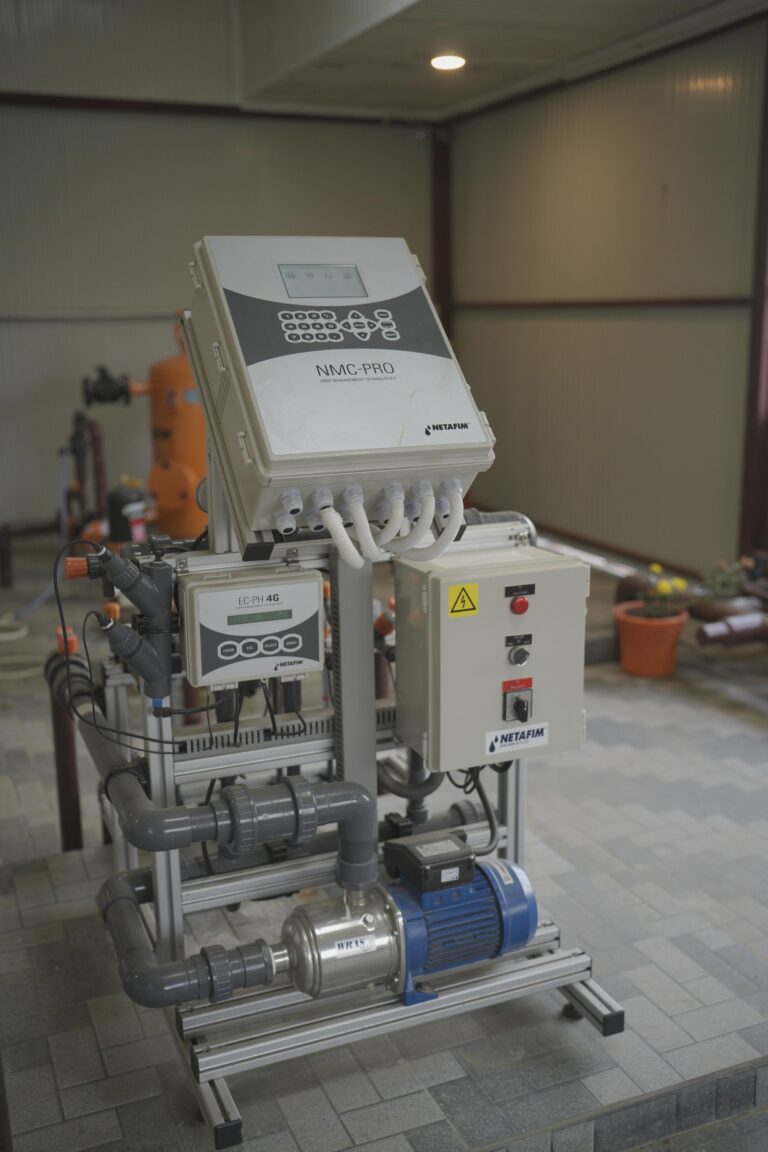
Automated Drip Irrigation: Delivering Water and Nutrients with Precision
Irrigation plays a crucial role in orchard management, particularly in regions with limited rainfall. Traditional irrigation methods, such as sprinkler irrigation, can be inefficient, leading to water loss through evaporation and runoff. Drip irrigation, on the other hand, delivers water directly to the plant’s root zone through a network of tubes and emitters, minimizing water waste and maximizing water use efficiency.
The use of this drip irrigation systems in this orchard further enhances precision and efficiency. KNF provided assistance to a technology company in developing a system that operates efficiently on hilly terraces, sloping terrains. These automated systems include advanced features such as:
- Pressure-compensated emitters: Ensuring uniform water distribution even on sloping terrain.
- Dripperline with integrated emitters: Simplifying installation and maintenance.
- Automation capabilities: Enabling precise control over irrigation scheduling and nutrient delivery operated through senson control on the Cloud. This allows for remove operation over the internet.
By integrating automated drip irrigation with soil moisture sensors and weather data, the orchard managers can implement a highly precise irrigation schedule, delivering the optimal amount of water to each tree and blueberry plant based on its specific needs. This precise water management is crucial for fruit quality, preventing water stress and optimizing fruit size and fructose content.
Biofertilization: Harnessing the Power of Natural Resources
While chemical & fossil fuel fertilizers have played a significant role in increasing agricultural productivity, their overuse can have detrimental effects on the environment and human health. Biofertilizers, derived from natural sources, offer a sustainable alternative by enhancing nutrient availability and promoting soil health. This orchard is presently employing a unique biofertilization strategy based on GauMutra and biodigester slurry. The biomass is available from the animals ( mainly Indigenous Cross Cows ) which is provided through a biodigester through this system. These experiments may also pave way for efficient deployment of Natural Farming input Jeevamarit in the near future.
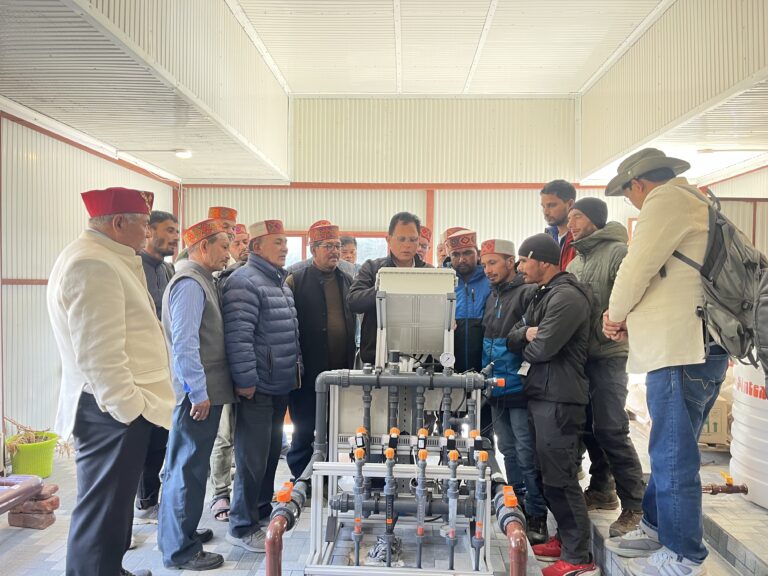
GauMutra (Cow Urine): A Rich Source of Nutrients and Biostimulants
GauMutra, a traditional component of Ayurvedic medicine and Indian agriculture, has been recognized for its potential as a biofertilizer and biopesticide. Research has shown that GauMutra contains various nutrients, including nitrogen, phosphorus, potassium, and micronutrients, as well as beneficial microorganisms and plant growth hormones.
Studies have demonstrated the positive effects of GauMutra on plant growth and yield. For example, a study by Pathak et al. (2005) found that application of GauMutra significantly increased the growth and yield of chickpea. Other studies have reported similar results for various crops, including wheat, rice, and vegetables. GauMutra also exhibits antimicrobial properties, which can help suppress plant diseases.

1. Macro- and Micronutrients:
Nitrogen (N): GauMutra contains urea, a readily available form of nitrogen that plants can directly absorb. Nitrogen is a crucial macronutrient essential for chlorophyll synthesis, protein production, and overall plant growth.
Phosphorus (P): While present in smaller quantities than nitrogen, phosphorus in GauMutra contributes to root development, flowering, and fruit set. It also plays a vital role in energy transfer within the plant.
Potassium (K): Potassium is essential for various physiological processes, including enzyme activation, water regulation, and carbohydrate translocation. It enhances fruit quality, disease resistance, and stress tolerance.
Micronutrients: GauMutra contains trace amounts of essential micronutrients like iron (Fe), zinc (Zn), copper (Cu), manganese (Mn), and molybdenum (Mo). These micronutrients, although required in small quantities, are crucial for various enzymatic reactions and metabolic processes.
2. Biologically Active Compounds:
Ammonia: As mentioned, under chemical farming urea is a primary source of nitrogen. Its rapid conversion to ammonia in the soil makes it readily available to plants. However, in this case Cow Urine is also a viable source of the same for plants.
Allantoin: This compound is known for its cell proliferation and wound-healing properties. In plants, it may promote root growth and enhance nutrient uptake.
Growth Hormones: GauMutra may contain small quantities of plant growth hormones like auxins, gibberellins, and cytokinins. These hormones regulate various aspects of plant development, including cell elongation, stem growth, and fruit development.
Enzymes: The presence of enzymes like urease (which breaks down urea) and phosphatase (which releases phosphorus from organic compounds) can enhance nutrient availability in the soil.
3. Antimicrobial Properties:
Several studies have reported the antimicrobial activity of GauMutra against various plant pathogens, including bacteria and fungi. This activity is attributed to the presence of compounds like phenols, creatinine, and urea. This can contribute to disease suppression in orchards.
Scientific Evidence for GauMutra’s Effects:
Improved Growth and Yield: Studies have shown that GauMutra application can enhance plant height, leaf area, chlorophyll content, and ultimately, crop yield in various plants. The specific effects on apple and blueberry plants require further targeted research, but the general principles suggest positive influences on growth parameters.
Enhanced Nutrient Uptake: GauMutra can improve the availability and uptake of essential nutrients by plants. This can be particularly beneficial in nutrient-deficient soils.
Disease Suppression: The antimicrobial properties of GauMutra can contribute to reducing the incidence of certain plant diseases, potentially reducing the need for synthetic pesticides.
Reducing Waste and Boosting Income: Apple Juice Production from Imperfect Apples
To minimize losses and provide additional income for apple farmers, we’ve introduced a plan to produce apple juice from apples that don’t meet the strict standards for fresh market sales. Apples often rejected for cosmetic imperfections, such as size, color, or minor blemishes, are still perfectly suitable for healthy consumption. Many of these apples, particularly Pithoo-grade apples, are discarded at the farm during harvest, despite meeting essential quality parameters. By utilizing these apples for juice production, we can reduce waste and offer farmers a new revenue stream. This initiative not only helps prevent food waste but also ensures that even “imperfect” apples can contribute to a healthy and profitable industry.
Biodigester Slurry: A Nitrogen-Rich Organic Fertilizer
Biodigesters convert organic waste, such as animal manure and agricultural residues, into biogas and nutrient-rich slurry. We, at Kalasan, also use the non-feedable kitchen waste into the biodigester mixed with GauMutra. The slurry is a valuable organic fertilizer containing high levels of nitrogen, phosphorus, potassium, and other essential nutrients.
The use of biodigester slurry as a fertilizer offers several advantages:
- Nutrient Recycling: Converting waste into valuable resources.
- Improved Soil Health: Enhancing soil structure, water retention, and microbial activity.
- Reduced Reliance on Chemical Fertilizers: Minimizing environmental impact and reduced input costs.
1. Nutrient Composition:
Nitrogen (N): Biodigester slurry is particularly rich in nitrogen, often in the form of ammonium (NH₄⁺), which is readily available to plants. The anaerobic digestion process converts organic nitrogen into inorganic forms, making it more accessible.
Phosphorus (P): Biodigester slurry also contains significant amounts of phosphorus, although often in organic forms that require mineralization by soil microorganisms before plant uptake.
Potassium (K): Potassium is another essential macronutrient present in biodigester slurry.
Micronutrients: Like GauMutra, biodigester slurry contains various micronutrients, contributing to overall plant health.
2. Organic Matter and Soil Improvement:
Enhanced Soil Structure: The organic matter in biodigester slurry improves soil structure by increasing aggregation, porosity, and water-holding capacity. This creates a more favorable environment for root growth and nutrient uptake.
Increased Microbial Activity: Several studies have reported the antimicrobial activity of GauMutra against various plant pathogens, including bacteria and fungi. This activity is attributed to the presence of compounds like phenols, creatinine, and urea. These microorganisms play crucial roles in nutrient cycling, disease suppression, and overall soil health.
3. Reduced Pathogen Load:
The anaerobic digestion process in biodigesters can significantly reduce the population of pathogenic microorganisms present in the original organic waste. This can contribute to disease suppression in agricultural systems.

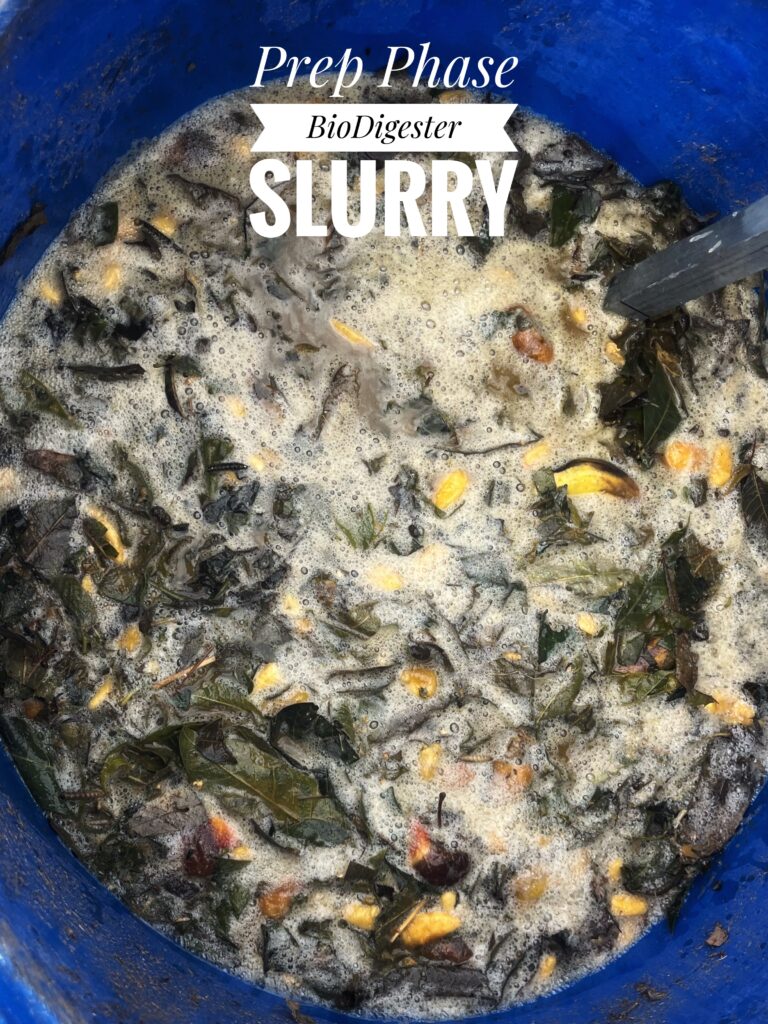

Type of BioDigester used:
In September 2024, we installed a 5000 L BioDigester Tank. Although the results are much more immediate in the summer, the digestion process took a lot longer in our area due to the low temperatures. It needs a minimum temperature of 14°C to function, but the temperature in our area on average is only 7°C. Since plant dormancy prevents the results from being definitively answered at this time, we will continue to experiment, particularly in the spring and summer, and present the findings.
Type of BioDigester used:
In September 2024, we installed a 5000 L BioDigester Tank purchased from Gujarat. Although the results are much more immediate in the summer, the digestion process took a lot longer in our area due to the low temperatures. It needs a minimum temperature of 14°C to function, but the temperature in our area on average is only 7°C. Since plant dormancy prevents the results from being definitively answered at this time, we will continue to experiment, particularly in the spring and summer, and present the findings.
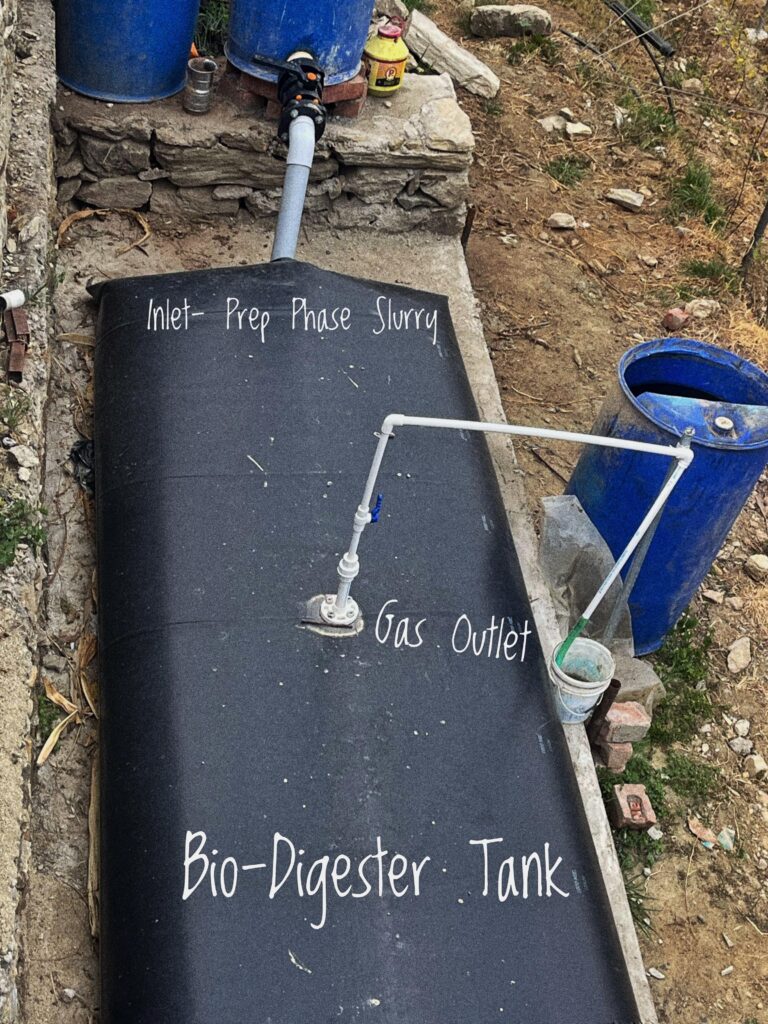
Scientific Evidence for Biodigester Slurry’s Effects:
Improved Crop Yields: Some studies have demonstrated the positive effects of biodigester slurry on crop yields across various plant species. The increased nutrient availability and improved soil health contribute to enhanced plant growth and productivity.
Enhanced Nutrient Uptake: Biodigester slurry can improve the uptake of essential nutrients by plants, particularly nitrogen and phosphorus.
Improved Soil Health: The application of biodigester slurry can enhance soil physical, chemical, and biological properties, leading to improved soil health and fertility.
Integrating Biofertilization with Automated Drip Irrigation
In this orchard, we recently have started integration of GauMutra into the automated drip irrigation system, allowing for precise and targeted delivery of nutrients to the root zone. We wanted to try using slurry in the automation as well, but due to the low temperature, the preparation & proper digestion of the waste are taking a long time, therefore we are still using GauMutra. This fertigation approach offers several benefits:
- Enhanced Nutrient Uptake: Delivering nutrients directly to the roots maximizes their availability to the plants.
- Reduced Nutrient Loss: Minimizing nutrient leaching and runoff.
- Precise Nutrient Management: Tailoring nutrient application to the specific needs of the trees and blueberry plants.
This integrated approach combines the efficiency of drip irrigation with the benefits of biofertilization, creating a sustainable and highly effective nutrient management system.
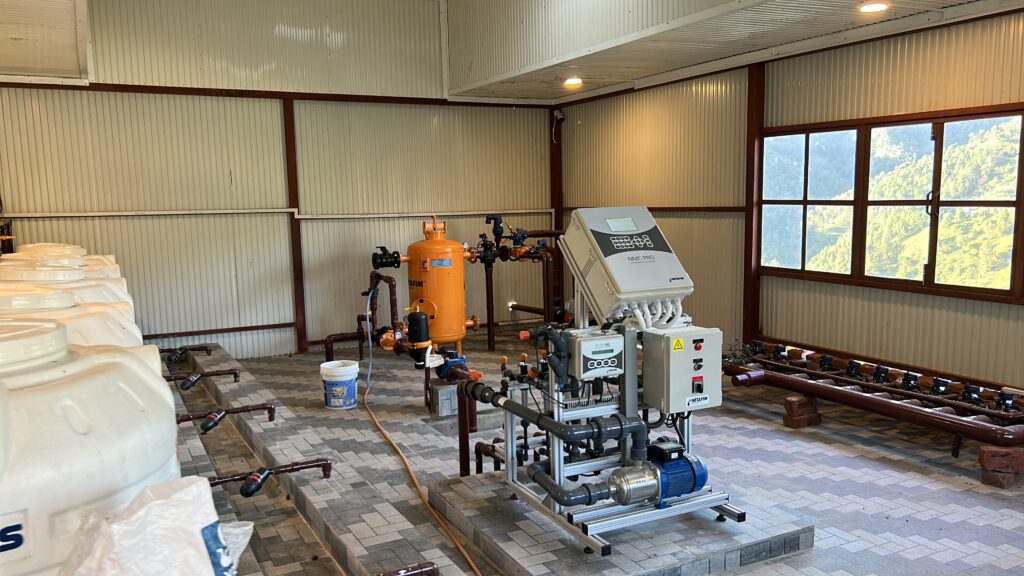
Implementation in the Orchard: 14,000 Apple Trees and 3,000 Blueberry Plants
The described integrated system is implemented across the orchard comprising 14,000 Apple (Malus domestica) trees and 3,000 blueberry (Vaccinium corymbosum) plants.
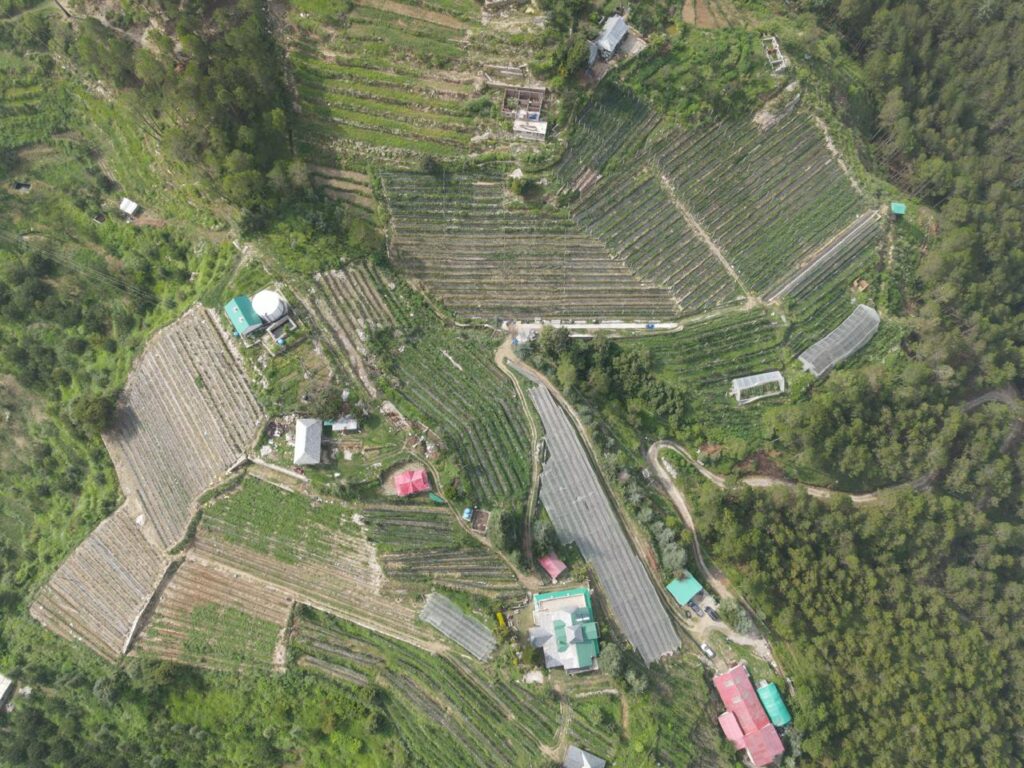
Results:
- For Apple
Apple trees require a balanced supply of nutrients for optimal growth, fruit development, and tree health.
GauMutra, containing nitrogen, phosphorus, potassium, and micronutrients like iron, zinc, and boron, supports key growth stages.
Nitrogen promotes vegetative growth, leaf development, and fruit size. Phosphorus aids root development, flowering, and energy transfer. Potassium enhances fruit quality, sugar/fructose content, and stress resistance. Micronutrients are vital for enzymatic processes, with Boron critical for pollen germination and fruit set. Applied via fertigation, GauMutra improves nutrient uptake, benefiting fruit size, quality, and set. Its antimicrobial properties may help suppress apple diseases and support integrated pest management. Additionally, it enhances soil health by stimulating microbial activity, fostering better nutrient cycling and root vigour
.
- For Blueberry
Blueberries thrive in acidic soils (pH 4.5–5.5), presenting challenges for using GauMutra, which is slightly alkaline (pH 7–8). To avoid altering soil pH, maintaining acidity through amendments like elemental sulfur, peat moss, or acidifying fertilizers is crucial, with regular pH monitoring to ensure optimal conditions. GauMutra can still supply key nutrients such as nitrogen, phosphorus, potassium, and micronutrients essential for blueberry growth, fruit set, and quality. By carefully managing its application alongside pH adjustments, GauMutra can contribute to nutrient provision without compromising the acidic soil requirements of blueberries.
Challenges and Future Directions
While the integrated approach has shown promising results, some challenges remain:
- Standardization of GauMutra and Biodigester Slurry: Ensuring consistent nutrient content and quality.
- Optimizing Application Rates: Determining the ideal application rates of GauMutra and biodigester slurry for different growth stages and environmental conditions. For this feedback from soil monitoring sensors may also be considered for integration into the system.
- Long-Term Monitoring: Assessing the long-term effects of the integrated system on soil health and orchard productivity.
- Ensuring the best Quality: To prevent clogging of the filters of Drip, we need to ensure best quality and accurate ppm rate.
- Remote operative Complexity: Full remote access of these devices requires a sophisticated setup of IoT vision, and algorthmic analytics on the Cloud. Our farm may take that pathways once the overall return of the present installation is justified.
- Research Documentation – At present the system is deployed and it shall require documentaiton on plant, soil health and stablising yield of the fruit production.
- Net Returns and Cost Recover studies – Based on the forthcoming yield trail and net returns to KNF, it shall have to be discovered and documented on the commercial returns of such a system and the time duration of such a return.
Future research will focus on addressing these challenges and further optimizing the integrated system. This includes developing standardized protocols for GauMutra and biodigester slurry production, conducting field trials to determine optimal application rates, and implementing long-term monitoring programs to assess the sustainability of the approach.

Scientific & Future Research:
While the scientific evidence supporting the benefits of GauMutra and biodigester slurry is growing, more specific research is needed on their effects on apple and blueberry plants. Future studies should focus on:
- Determining optimal application rates and methods for both GauMutra and biodigester slurry for apple and blueberry production.
- Investigating the long-term effects of these biofertilizers on soil health, tree/plant growth, fruit yield, and fruit quality.
- Evaluating the economic and environmental benefits of using these biofertilizers in orchard management.
- Analyzing the specific microbial communities associated with the use of these biofertilizers and their role in nutrient cycling and disease suppression.
By conducting rigorous scientific research, we can further validate the benefits of GauMutra and biodigester slurry and optimize their use in sustainable orchard management practices.
Conclusion:
The integration of precision agriculture, automated drip irrigation and biofertilization using GauMutra and biodigester slurry represents a significant advancement in sustainable orchard management. This integrated approach offers a promising pathway towards increasing fruit production while minimizing environmental impact. While such systems have initial capital costs to setup and run, they take about 5-6 years to recover the costs for benefits. Small farmers may be unable to install these, however, cluster of farmers through FPCs may consider its application in the future. The successful implementation of this system in the orchard with 14,000 apple trees and 3,000 blueberry plants demonstrates the potential of this approach to revolutionize fruit production and contribute to a more sustainable agricultural future. Although a year of implemention is yet to be done, but the effects have been showen in the growth of the trees vegetatively for now. We will keep updating. Ending the conclusion with, Kalasan Nursery Farm offers free visits to farmers from all across India, if you are interested in visiting the farm as a rookie you can contact through the website / email – farm.kalasan@gmail.com
